Today’s article is about how to tell the difference between male vs. female turkeys.
If you are new to turkey hunting, figuring out the sex and age of a turkey can seem daunting.
But with a little knowledge and practice, you will soon find yourself able to tell the difference with ease.
Let’s jump right in…
What are the differences between male and female turkeys?
Knowing the differences between a male and female is essential whether you are preparing for spring hunting season or raising turkeys.
If you come up on a group of turkeys when hunting, you need to be able to tell a tom, hen, and jake apart.
Size
Male turkeys tend to be larger than females. This is because the male tends to use its size and strength when it comes time for mating season. The male will not only look much bigger, but he’ll also have a large fan-like tail that he will use to fan out his feathers to look larger and more impressive to the female.
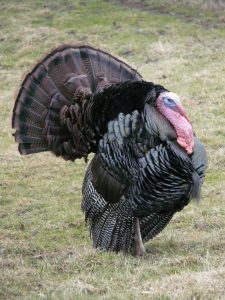
On the other hand, females are smaller in size and do not fan their tails out to look bigger and more impressive. If you look at the size of their tail and compare it to that of a male’s, there is no comparison because females don’t have much in the way of fanning out feathers as males do. Females don’t need a flashy way to attract mates as they have a different strategy. Instead of using bright colors or impressive features, they have other ways of attracting their male counterparts.
Body Features
Males and females have a number of different body features that can be used to distinguish which is which.
They include:
- Feather differences
- Beards
- Spurs
- Head differences
The coloration of male and female turkeys is also different, with males having a more metallic look to their feathers, while females are usually duller in color. This isn’t always the case, but it is generally true that males are more brightly colored than females.
We will get into more detail on these features in the sections below.
Feeding
Although turkeys have the same diet, male and females also eat differently. Males are typically more aggressive when it comes to food and will often compete for the best spots at the feeder. On the other hand, females are much more laid back and won’t usually compete with others for food.
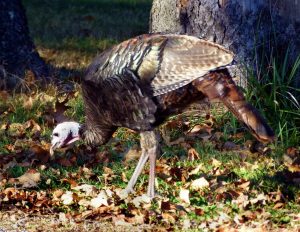
The easiest way to tell the two sexes apart when you’re not able to see them up close has to do with the sound they make. Males will gobble while females will cluck. This is why it is important to have a good understanding of how often to call a turkey.
How Can You Tell the Difference?
If you’re still not sure which sex your turkey is, take a look at the information below to distinguish the physical differences between the two.
Turkey Beards
The presence of a beard is the most reliable method for determining whether a turkey is male or female. All males have beards, while females do not.
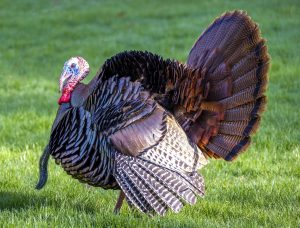
A turkey’s beard is made up of long, thin feathers that hang down from the lower part of the chest. The beard is typically the same color as their tail. The beard is one of the most easily identifiable features of a male turkey and is something that you can’t miss even if you’re not sure what you’re looking for.
Feathers
Male turkeys have more colorful feathers than females, and they are also typically more brightly colored. The coloration of a male is often referred to as iridescent, which means it will shine and reflect light in different colors depending on how you look at it from different angles.
This isn’t always true for both sexes as there are some cases where males are duller in color and females are more brightly colored, but it is generally the case that males have more vibrant feathers than females.
Tail Feathers
The tail feathers of males are much more impressive than those of females, as the males fan them out in an attempt to look bigger and show off. The female’s tail may be smaller, but they don’t fan them out as males do.
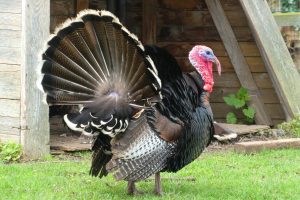
The tail feathers of a male are also longer than those of females and will often curl up at the end instead of lying flat against their bodies. The female’s tail usually lie against their backs more neatly.
Breast Feathers
Another way to tell males and females apart is by looking at their breast feathers.
The breast feathers of males have black tips while those of females do not. Females have brown or white without any black tips.
These feather tips can also help you determine which sex your turkey is if they’re too young to tell by looking at their wattles and snoods (see below).
Head Feathering
The head feathering of a turkey can sometimes be used to distinguish between males and females. Most males have featherless heads, while females will have a small tuft of feathers on the top of their heads.
Snood
Aside from the size, beards, and coloration mentioned above, male turkeys also have a snood. The snood is a fleshy protuberance on the head that extends from the beak and goes up towards the forehead. The male’s fleshy red coloration can be seen when they are excited or display themselves to attract females.
Females, on the other hand, have small snoods or no snoods at all. Their heads will look relatively smooth compared to males who have this noticeable feature.
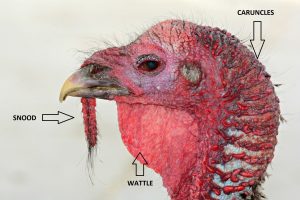
Wattle
The wattle is a piece of skin that hangs down from the neck and is used by the male to attract mates. It’s also a way for the males to communicate with each other, as they will puff out their wattles when trying to assert dominance over others.
Males have a more pronounced wattle than females.
The wattle on a female is usually much smaller than a male and doesn’t hang down as far. Females also don’t use their wattles to communicate with other wild turkeys.
Caruncles
These are small, fleshy protrusions on the head of a turkey. Males will have more caruncles than females, and they are also larger than males.
Males have the most developed caruncles, especially when aroused. Females tend to have less prominent caruncles, and they are also much smaller in size compared to males.
Leg Spurs
Male wild turkeys will also have spurs that are sharp protrusions on their legs to fight. Depending on how old the turkey is, they may or may not be visible, but if you can see them, then it’s a good sign that your turkey is male. Females do not have these spur-like protrusions on their legs.

So in summary, the difference between male and female turkeys are quite noticeable once you get to know them. By learning the differences you’ll be able to identify the sex of wild turkeys with ease.
What are the differences between Tom and Hen Turkeys?
Adult male turkeys are also called toms, while adult female turkeys are called hens.
These names can be a little confusing because it isn’t always easy to tell whether you’re looking at an adult turkey or a younger one just by looking at them, and their sex may not match what you would assume based on the name. This is why it’s important to learn the differences between male wild turkeys and females so that you can accurately identify them.
There are a few differences in size and weight. The adult tom turkey is larger than the female hen, and they typically weigh a little more. Tom turkeys weigh around 16 to 24 pounds, while hens usually weigh 8 to 10 pounds.
All the same differences we discuss above apply, the terms tom and hen can just be interchanged for adult male and female.
Quick Recap
As to their physical appearance, the head of tom turkeys do not have feathers on the top like hens do. Instead, they have a fleshy protuberance called a snood which hangs over their beak. Their wattles are also larger than those of the female turkey. Also, tom turkeys have beard feathers which the female turkey does not have.
Tom feathers are also more vibrant than that of a hen turkey. Specifically, tom turkeys have black breast feather tips, and their overall body feathers have red, copper, gold, bronze, or green highlights. On the other hand, hens have brown, gray, or white breast feather tips, and their overall body feathers are generally a blending of browns, grays, and whites.
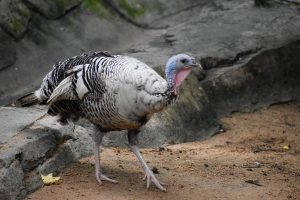
Toms also have leg spurs, while hens do not. Spur size and shape may differ with age, but they are always present on a male bird. To display dominance, toms will often fan out the feathers on their tail, puff up their body, and strut around, while hen turkeys do not.
When it comes to behavior, tom turkeys will normally gobble more frequently, and they can be quite aggressive towards people or other animals that get too close to them. On the other hand, hen turkeys only make soft yelps and clucks, and they never gobble.
Which leads us to the question…
What is a Gobbler?
A gobbler is a male that has reached adult maturity or what we now know as toms. Shifts in physical appearance and behavior will occur as they become older, but a gobbler is deemed one after it turns two years old.
At this point, it has all the features of an adult male – including a beard and spurs.
Gobblers will spend their time strutting around to attract female mates and fighting other males who challenge them for dominance or try to take over their territory. Gobbling is also common among mature turkeys as they use it to communicate with other wild turkeys. They will typically gobble when they are scared, excited, or want to claim their territory from other male turkeys.
Jake Vs. Tom Turkeys
A jake is another name for a young male turkey that has not yet reached adulthood.
There are a few differences between a jake turkey and a tom turkey. The main differences are their physical features such as beards, head color, tail feathers, spurs, and behavior.
Tom turkeys have long beards, extending up to 10 inches long. Jakes will have short beards roughly 2 to 3 inches in length.

A tom turkey’s head is generally redder in color, and it may have a lot of white on the top and back of its head. On the other hand, jake’s head is paler in color, with just a little bit of red on the head and neck.
Toms often strut around with their tail feathers fanned out. Jake turkeys do not fan their tails out as often, and they have less dramatic tail feather coloration, primarily black with a little bit of white.
The most apparent difference between a tom turkey and jake is the presence of spurs on a tom’s legs. Spurs are tiny in juvenile jakes, and they start to grow at around 16 months old.
Lastly, the behavior of a tom turkey is noticeably more aggressive than that of jake. Toms often gobble more frequently, and they can be quite territorial towards people and other animals. Jake turkeys are not as aggressive and tend to be more docile. They will still gobble occasionally, but not as much as a tom.
How Turkeys Change With Age
There are no notable changes in juvenile female turkeys as they transition into adulthood, but young males will gradually develop the physical characteristics of an adult male.
Young Turkeys
As we learned above, juvenile male turkeys that have not yet reached sexual maturity are called jakes.
When a baby male turkey or poult reaches one year old, it is then called jake. That is why jakes are often called “one-year-old” or “yearlings.” For the most part, jakes are similar to hens in appearance because they do not have any beards or spurs yet, and their body feathers are more brownish-gray than the black of adult males.
Most jakes will grow beards and spurs at around 16 months old but not all will. Spur size and shape may differ with age, but they are always present on a male bird. Jakes will also start to develop the coloration of adult turkeys as they get older.
As jakes get older, his body feathers turn from brownish-gray to the more common coloration of adult male turkeys. His beak changes in appearance, too – becoming redder with a dark tip bordered by yellow. He will also start to gobble at around six months old.
Adulthood
When a jake reaches sexual maturity, his behavior changes, and he becomes more aggressive than before. He will also begin to gobble constantly.
Once a jake reaches two years old, he is now called a tom turkey. At this point, he has all the features of an adult male – including a beard, spurs, and distinct coloration.
Age and Breeding Relationship
Males and females also transition to adulthood at different ages. Males become adults at around two years old, while females become adults around one to two years old.
The behavior of males and females changes when they reach adulthood. Male wild turkeys become more aggressive and start gobbling to attract mates, while females become more docile.
When do turkeys breed?
Turkeys breed in the early spring and late summer. The beginning of the breeding season is around mid-March, and the end is around May. At this point, male turkeys spend the entire period gobbling and strutting to attract mates. Their snoods also become bright red and engorged, and their tails spread out as they do a mating display.
Toms will mate with multiple females during the breeding season. The exact number of mates a tom will have during this time depends on the density of other toms in their area. In areas with fewer toms, each one can mate with multiple females as it has less competition for mating partners.
After the mating season is over, male turkeys lose their interest in females and begin to focus more on self-maintenance. They stop gobbling and strutting around, and their snoods and tails return to normal. They also start molting, which is when they lose their feathers and grow new ones. Molting lasts for about six weeks.
Conclusion
Knowing how to accurately label a turkey is required when turkey hunting.
Hopefully after reading the article above, you now feel more confident about your ability to tell the difference.
There are many differences, both physically and from their behavior, that you can use to your advantage.
You will be well on your way to enjoying some delicious wild turkey meat.
If you enjoyed this article and would like to learn more, checkout our page on turkey hunting that has a list of articles you might be interested in.